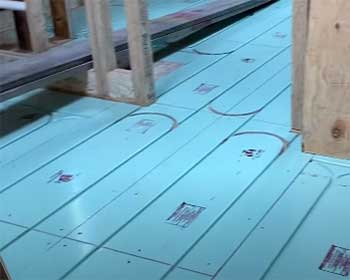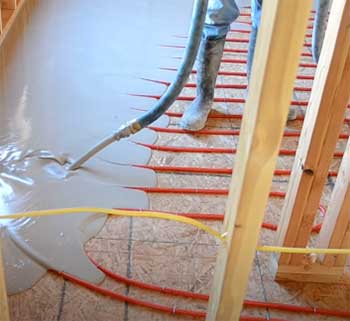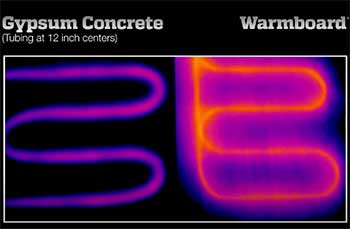Warmboard is more responsive than GypCrete and heats up pretty fast because Aluminum can transfer heat better than concrete. On the other hand, GypCrete drops temperature slower than Warmboard, and it has more mass which distributes temperature more evenly.
Care for a secret?
A radiant floor heating system is the ultimate choice for many people’s warm and cozy homes. Currently, there are two technologies that people mostly use, aluminum-based Warmboard and concrete-based GypCrete.
Let’s look at their differences and see which one will be an excellent choice for you.
A Quick Comparison Table
| Specification | Warmboard | GypCrete |
| Product Type | Aluminum-Based Radiant Floor Heating | Concrete-Based Radiant Floor Heating |
| Special Feature | Flexible Tubing Layouts | 140 UL Fire-Resistance Rated |
| Available Variant | 2 Available Variants | Only 1 Variant |
| Performance | Fast Heating, Fat Cooling | Slow Heating, Slow Cooling |
| Cost | About $8 Per Square Foot | $2 to $6 Per Square Foot |
Key Comparisons Between Warmboard And GypCrete
- Different Type

Warmboard and GypCrete are hydronic radiant floor heating systems, but they are two different systems made of different materials.
Warmboard is a panel-type subfloor made from plywood and aluminum sheet.
These panels are installed directly over the joist and add a flooring layer.
On the contrary, GypCrete as an alternative is a composite mixture made from a fixed ratio of Portland cement, sand, and gypsum plaster. You have to make a perfect mixture and then pour it on the floor through the hose attached to a pump.
- Features
Installing Warmboard is like installing any other subfloor and doesn’t require extra sills or seismic shear engineering. Besides, you won’t have to worry about drying time or weight issues. You can cut, glue, and nail these panels.
On the other hand, GypCrete is specially formulated for radiant floor heating and virtually works on all floor coverings. By sealing perimeter walls, it keeps out baseboard drafts. It is fire-resistant rated.
- Available Variant
Warmboard-S is a 4-panel type panel with 1-1/8 inches thickness and 4 feet by 8 feet size. Warmboard-R is a 2-panel style board with 13/16 inches thickness and 2 feet by 4 feet size.
In contrast, GypCrete is just like cement and doesn’t have any other variant. It’s a mixture of cementitious and filler.
- Performance

You will find different heating performances from these two systems.
Warmboard heats up pretty quickly and cools down fast because of the Aluminum.
So, you can turn it on and off quickly as per your need.
On the contrary, GypCrete heats slowly and cools down slowly as well.
So, you will get a warm floor long after you turn it off. This can be beneficial to some people and problematic to others.
- Cost
Warmboard is more expensive upfront. You must spend around $8 per square foot to install these panels. On the other hand, GypCrete will cost $2 to $6 per square foot to install, depending on the contractor.
Which Will Be Best For You?

When choosing a radiant heating floor system, the heating factor should be your priority.
If you like fast heating and cooling, you should go with Warmboard, and if you need slow heat building and cooling, then GypCrete is your ideal choice.
But I prefer and suggest Warmboard. It is more convenient and easy to install.
Plus, you will find it easier to repair.
Frequently Asked Questions (FAQ)
Warmboard is a good quality hydronic radiant floor heating system installed under your floors. These boards are installed over joists as the subfloor, and then the tubing is done. Finally, you have to use an extra protective layer which can be plywood or any other material to cover the Warmboard panels.
GypCrete is a concrete-based hydronic radiant floor heating system. To install it, you have to pour GypCrete on your floor. Typically, the maximum depth for GypCrete is 3 inches. You can have more depth than that, but you must contact an authorized dealer for that task.
There are two types of Warmboards, a 4-panel Warmboard-S and a 2-panel Warmboard-R. These two variants come in different thicknesses. Warmboard-S panels are made from Douglas Fir 7-ply plywood and are 1-1/8 inches thick. On the other hand, Warmboard-M panels are made from aspen & pine-oriented strand board and have 13/16 inches thickness.
Yes. You can install Warmboard over a concrete floor. Warmboards have plywood surfaces with aluminum sheets. They have an excellent heating capability that is quick and comfortable. One of the best things about Warmboard is that you can install them over both concrete floors and wood-framed floors.
Final Thoughts
The differences between Warmboard and GypCrete are huge; they are two completely different types of products. But Warmboard seems more convenient as they are panel ready for installation.
So, there’s no hassle of making mixtures and pouring them evenly on the floor. Most importantly, it will make your floor warm much quicker, which you will need in the winter.

Thanks for this info – nice details in streamlined format. I am building a new house in Alaska, and my builder generally uses Gypcrete, so I am doing a lot of my own research. Your article helped. Any comments on how well the Warmboard boilers and pumps work? Reliability? Noise? Since the thermal mass is less with Warmboard compared to Gypcrete, I presume the pumps will need to cycle more often, and wondering how this might affect the lifespan.